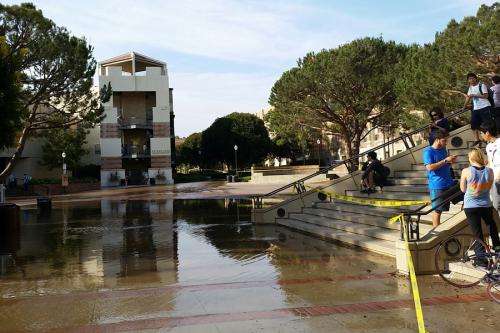Stopping the leaks

When a big old cast-iron water main blows, it certainly makes for a spectacular media event.
The helicopters were swarming in late July when a burst main ripped a giant hole in Sunset Boulevard and flooded the University of California, Los Angeles campus. That bit of excitement cost millions of dollars in damage, disruption and lost resources.
Sydney has had its fair share of ageing water infrastructure incidents, too – Harris Street in Ultimo became a temporary lake last year; in 2009, two cars and a power pole were swallowed in a 25-metre crater at Bellevue Hill.
Right now in LA they're contemplating the fact that 65 per cent of the city's water is carried in old cast-iron pipes. On this side of the Pacific, Sydney Water is leading a $16 million, five-year international research effort to better assess the condition of underground pipes and identify trouble spots well ahead of failure.
The water authorities in LA and many other cities will be eagerly awaiting the results coming from Sydney Water's test bed, a 1.5km section of decommissioned cast iron pipe at Strathfield, in Sydney's inner west, according to research team member Associate Professor Jaime Valls Miro from the University of Technology, Sydney (UTS).
That pipe, laid in 1922, has become the world's first test bed for advanced techniques to assess pipe condition, using a range of electromagnetic and acoustic sensors that can be located on the outside surface of pipes or carried through them.
The team gathering and interpreting the data includes researchers from UTS, Monash University and the University of Newcastle.
The UTS researchers, from the university's Centre for Autonomous Systems, are developing "machine learning" software tools to crunch the data coming from the various sensors to accurately profile the thickness of a section of pipe and detect any defects.
"It involves processing a vast amount of data from several types of assessment tools," says Professor Valls Miro. "The aim is to remove the guesswork from critical pipe inspection, with wide application for any city with ageing water infrastructure."
Besides Sydney Water and six other Australian water authorities, the US Water Research Foundation and UK Water Industry Research are partners in the project.
It's not just about heading off major incidents. Professor Valls Miro says being able to target maintenance where it's needed will lead to substantial cost savings and less wastage of a valuable resource.
It has been estimated the Australian water industry could save $160 million over 20 years using the results of the project, which is due to be completed in 2016.
Provided by University of Technology, Sydney

















